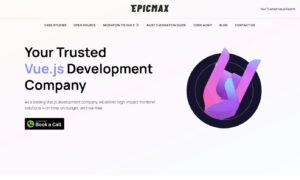Being a developer who has been in the field of digital innovation and backend development for many years now, I can reaffirm my statement about the power of Node.js that I have seen it. Node.js application optimization, apart from being a technical challenge, is the key to project success, enhancement of applications, and ensuring longevity in the case of fast-developing technology. In this paper, I am going to share the following: my Node.js best practices, real-world examples, and success stories that emphasize writing efficient code, agile software, and web development techniques. Besides, I would like to mention the fact that our company, Celadonsoft, a Node.js development company, implements these practices to build enterprise solutions that push the company up to the step to true technology success.
An insight into Node.js architecture and its pros
Node.js architecture is indeed an event-driven and non-blocking I/O model which, besides being the main reason for its suitability for real-time data processing, also ensures it is an excellent choice for scalable backend systems. Owing to this architecture, developers can efficiently manage many simultaneous operations without compromising the server’s productivity. Distributed programming is at the heart of Node.js which allows developers to use heavy I/O processes and at the same time deliver high performance. Using JavaScript in both server and client side promotes project management efficiency and fosters agile development process which have been cited as the major reasons why so many projects have utilized the Node.js platform.
Node.js sprinkling its design with the latest web development trends, thus allowing backend development teams to direct their attention on improvements of the application, does not rely upon multi-threading complexities. Whether you create enterprise solutions or creative projects, a system managing non-blocking I/O and asynchronous operations without any effort makes life easier.
The Most Effective Techniques for Code Optimization
The initial step toward optimizing the Node.js applications is to create the code that is efficient, clear, and with proper documentation. I will share the main techniques which I have found to be effective:
Adopt Asynchronous Programming:
The biggest asset of Node.js is its inherent asynchronous characteristic. By preventing blocking calls and employing callbacks, promises, or async/await, you can ensure that your app remains active and efficient. This is a crucial approach for both performance tuning and debugging techniques, making it possible for your server to process multiple requests at the same time without having to wait.
Center Around Code Optimization:
When you are either refactoring old code or adding new features, you must always be on the lookout for the most optimal code. Utilize tools for profiling to detect the parts of the program that are slow and do not avoid the use of caching in the right contexts. It is the methods like controlling the number of synchronous operations and the use of good libraries that would dramatically change the performance.
Employ Non-Blocking I/O:
Non-blocking I/O is the essence of building a scalable system. When you deal with I/O operations in an asynchronous way, you grant your application the chance to process other tasks in the meantime. This technique not only boosts the application performance but also leads to reduced loading time, which is a major factor in better success rates.
Adopting these practices in your development process ensures the high performance of the application while at the same time making it scalable and robust. During my time with several backend development projects, these principles always led me to create quicker, more dependable software – a trend that I have also seen in many Node.js case studies.
Creating and Scaling APIs Effectively
In the modern-day web development landscape, API speed is a key element in determining whether an application will succeed or not. When programming APIs in Node.js, bear these points in mind:
RESTful and GraphQL Endpoints:
Choose the most suitable API paradigm according to the requirements of your project. RESTful is the most popular API type and is very easy to use, whereas GraphQL is the way to go for complex queries. Both of them, when optimized, can aid in scaling and performance enhancement of the applications.
Cost-Effective Data Processing:
It is a good idea to skip the data processing on the server side that is not strictly necessary by guaranteeing proper endpoint design. Use Node.js’ asynchronous data fetching best practices to minimize overhead for example, and add-in middleware solutions for better request handling. This both decreases latency and complements agile development.
Strong Error Monitoring:
Optimizing API design necessarily includes all-inclusive error handling. Use try-catch blocks together with paragraph logging to capture errors without inflicting user experience. This kind of practice proves not only the debugging methodologies but also it reveals that success stories and real apps depicting scalable architecture have these characteristics recurrently.
Using Caching and Load Balancing
Caching is among the top methods for the application performance increase. Here’s how to apply caching and load balancing in your Node.js applications:
Implement In-Memory Caching:
Use Redis or Node’s caching modules to store data that is accessed frequently. This method considerably cuts down the amount of time needed to find the settings and, at the same time, it raises the efficiency of the server, which, in turn, is critical in real-time computing and digital innovation.
Adopt Load Balancing Techniques:
Node.js’s single-threaded design can be overcome by employing clustering and load balancing solutions. Distributing requests across multiple processes or servers can improve application performance, particularly under high load. Effectual load balancing is a prerequisite for the scalability of the system and it is a key element of many successful project implementations.
Utilize Microservices Architecture:
Splitting your application into smaller, easier-to-handle services is not only helpful for scaling but also for troubleshooting. Microservices make it possible to isolate and optimize each component separately, therefore the system as a whole becomes more flexible and easier to control.
These methods not only help out in performance but they also agree with the new trends in enterprise app development. In one of the most complicated projects, Celadonsoft added caching, and load balancing mechanisms so efficiently that it cut down the response time a lot – a case on how technological trends and backend development innovations could lead to real success.
Adapting to the Current Trend in Software Development
Optimization is not only about the code but also about the process. Implementing agile development and DevOps methods would result in quicker cycles and better products. Jot these points down:
Agile Methodologies:
The agile approach has the advantage that teams can carry out the necessary adjustments more rapidly, thus the project delivery is faster. Agile development not only fosters teamwork but also simplifies project management, a method that has shown great success in the majority of Node.js case studies and project evaluations.
DevOps and CI/CD Integration:
Automating the build, test, and deployment processes by using continuous integration/continuous deployment (CI/CD) pipelines runs less of the risk of error and improves time to market. The implementation of these practices as a single unit leads to performance tuning and code optimization being a part of the application lifecycle.
Frequent Performance Monitoring:
Use available resources like Grafana, Prometheus, and ELK Stack for the real-time monitoring of performance indicators. The careful observation of success metrics is an effective way to find the bottle necks and suggests an early proactive approach in adjusting things. This is an important strategy for a sustained high application performance.
At Celadonsoft, we are committed to staying ahead of the game with the integration of these modern development practices and the reflection of the latest tech trends and enterprise solutions in our Node.js applications learn more at https://celadonsoft.com/node-js-development-company.
Ratification: Lustra Technologies
Real-time data processing is a significant advantage of using Node.js. Its event-driven architecture is perfect for applications that require instant data updates. Here’s how you can enhance real-time abilities:
Make use of WebSockets:
Implement libraries like Socket.IO for two-way connection between the server and clients . This technique is mainly used in applications that require the exchange of data in real-time, including chatting applications or live-report analytics dashboards.
Process Data with Streams:
Node.js streams help you manage big datasets effectively by processing data in small pieces. This is very important for keeping low latency and high performance, even in times of heavy loads.
Integrate Message Queues:
Tools such as RabbitMQ or Apache Kafka can be used for the management and distribution of data in your application. This arrangement not just aids in scalability but also creates a dependable ground for dealing with asynchronous programming operations.
When you adopt these techniques to monitor the app’s performance, you can keep on SERVER efficiency and thus achieve better performance tuning. In addition to this, real-world examples mention many success metrics which prove that the efficiency of a robust monitoring system is essential for the optimization of long-term applications.
Advantages and Methodology
Нave been witnessing experiences about Node.js case studies from my start to finish career-that really proves the performance tuning and agile development are the topics in the forefront of technology progress. Although, the best projects are those that are built not just on efficient code, scalable architecture, and the desired continuous improvement, but also rely on these things.
If we talk about Celadonsoft, our main goal is to change challenges into opportunities and digital transformation. Group of specialists in our company utilizes the latest debugging methods, non-blocking programming, and strategy of API Optimization providing incredible solutions. It is truth that we have started with the performance quotients to clients and manifested them, in such a way, they have been turned into superprojects.
By the case studies and the success stories we share, we illustrate that loyalty to Node.js optimized practices and program code can give rise to tangible project success. From our side, the ideal application performance and lengthy breakthrough digital are obtained by a combination of, for example, real-time data processing, excellent load balancing, and new technology trends which are continuously integrated.
To conclude
Node.js application optimization is a rich assignment that needs you to be both partly a magician and a technician. At the same time, your attention must be given to both system low-level peculiarities and program development techniques, especially in the context of real-time processing and modern web development. With proper time management and outstanding testing skills, it will be possible to generate practically bug-free code and ensure project scalability; that is why your main focus should be on asynchronous programming, code expansion, scalable API design, and modern development paradigms within Node.js frameworks.
As a means of competing in the market, these practices are not only the best way to protect your company against things going out of date but also the foundation of digital innovation, system optimization, and enterprise development success. At Celadonsoft, we embrace these tactics in our daily activities; hence, our Node.js applications provide superb functionality. We go for agile development and fulfill the needs of developers who are lucky enough to work on the modern web.
To attain the project goal, enhance performance, and present modern examples of technological success, optimizing your Node.js applications is the key. Together we keep our creativity evolving, inspiring our peers with effective code, scalable frameworks, a deep focus on performance metrics, and an unflagging dedication to perfection.





































